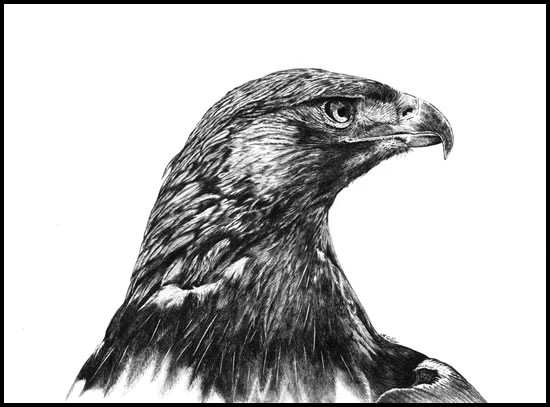| |
| |
| |
| |
| |
| |
| |
| |
| |
| |
| GOLDEN
EAGLE |
 |
| By any yardstick
the golden eagle qualifies as one of the world's most magnificent species.
Its piercing, bronze-eyed gaze exemplifies the expression "the look
of eagles." The species is not restricted to this continent, as our
national symbol the bald eagle is; the golden eagle is resident throughout
Europe, Asia, and North Africa, as well as North America. It is the most
numerous and widespread of the large eagles (eagle species vary greatly
in size, and some tropical eagles are no larger than hawks). Adult birds
are various shades of dark brown with golden-tipped feathers on the crown
and neck that give the species its name. The tail feathers are a mottled
dark gray or brown. Immatures differ in having a great deal of white on
the wings and tail. The white tail feathers with the black tip so prized
by western Native Americans come from one- or two-year-old birds. As the
eagle matures, each yearly molt brings in new feathers with less white.
By the time the bird is 5, 6, or 7 years old, the dark tail of maturity
has replaced the white tail of youth. The fact that golden eagles take
so many years to mature (they do not breed until at least the age of 5)
is a clue to their lifespan - they are long-lived birds, especially in
captivity where they are not subject to hunting accidents, electrocution
on high-tension wires, and human persecution. Wild birds may live up to
17 years if they're lucky; captive birds may live 40 years or more. Lakota,
the golden eagle Wingmasters cares for, was born in 1977 and is still
healthy and active. Golden eagle females average a bit over 10 pounds, while the smaller males average 8 1/2 pounds (in most raptor species, females are larger than males). Wingspan is over 6 feet, giving the birds spectacular powers of flight. The golden is a bird of the high country, and mountain ridges provide it with updrafts that enable it to soar for hours without a wingbeat. Its speed in the air rivals that of the peregrine falcon, although a golden can also quarter a hillside slowly, watching for movement. Its prey is usually a mammal such as a jackrabbit, ground squirrel or marmot. However, the eagle may also stoop like a falcon at birds in flight, catching grouse, herons and ducks on the wing. The young of deer and bighorn sheep are occasionally taken, but not the adults - the golden eagle, like other raptors, is an opportunist, and will take the easiest prey it can find. Stories of the species' lifting ability have been greatly exaggerated, and the birds are simply not capable of flying off with the sheep and deer that some reports have credited (or discredited) them with doing. Goldens are often accused by sheep ranchers of killing lambs, but studies have shown that in the majority of cases where eagles are found feeding from a lamb carcass, the lamb was killed by something else, such as a fall. The accusation of lamb killing and its reputation as a powerful predator have sometimes cast the golden eagle as a villain. Although the birds now enjoy full legal protection, and are in fact owned by the United States government (this is true of bald eagles as well), they are still subject to illegal shooting. However, the U.S. population seems to be fairly stable at this time, and may number 50,000. The vast majority of these birds live in the western states. The golden eagle is now classified as the rarest breeding bird in the eastern United States, and there are no nesting pairs in New England at present, although migratory golden eagles, probably from Canada, are recorded in New England every year. Habitat modification and environmental contaminants are the major reasons for the species' disappearance from the New England area, combined with trapping and shooting. However, goldens were never numerous in the Northeast, since their hunting style demands large open spaces. Heavily forested New England probably never boasted more than 30 nesting pairs. |
|
|